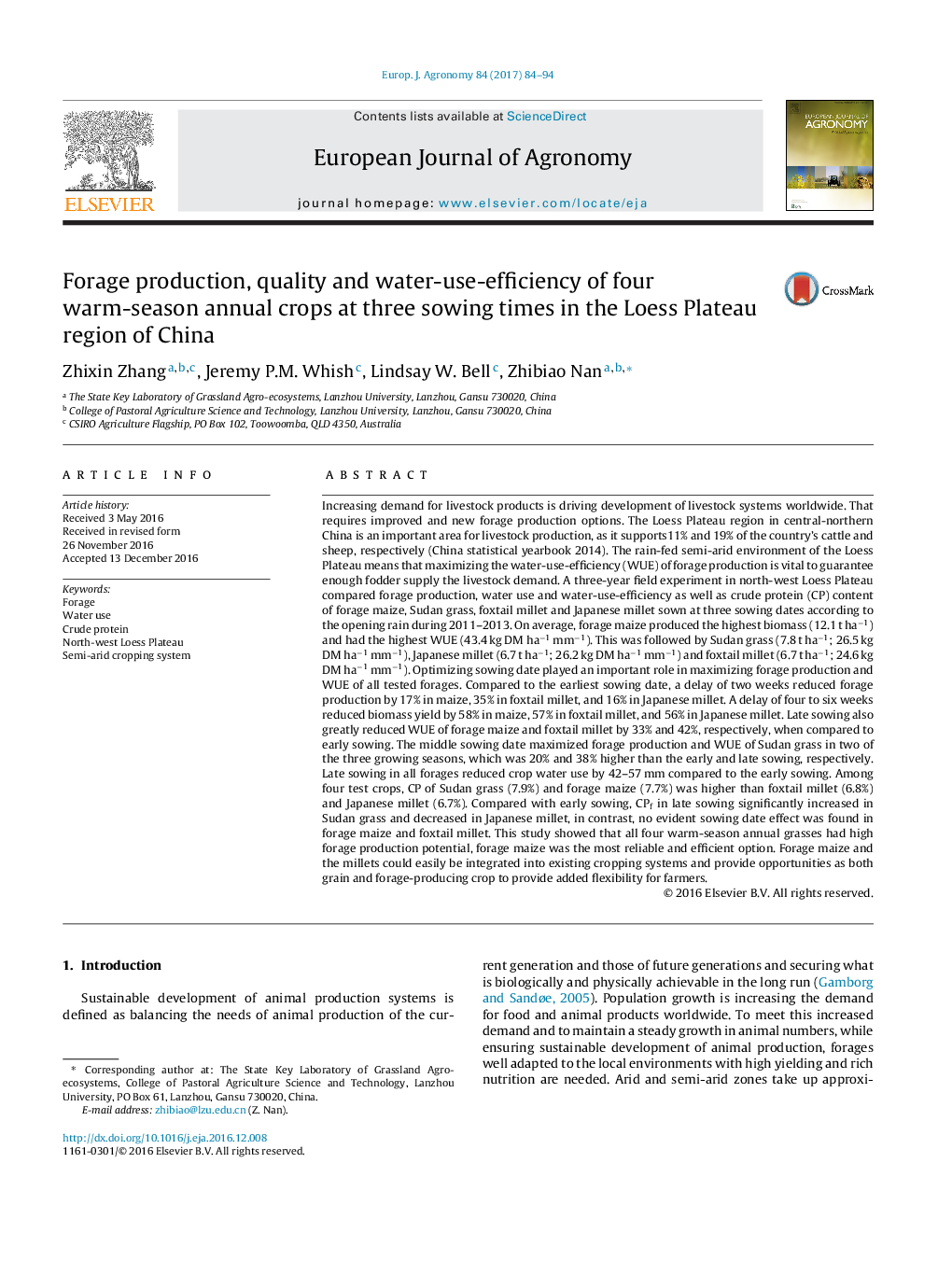| کد مقاله | کد نشریه | سال انتشار | مقاله انگلیسی | نسخه تمام متن |
|---|---|---|---|---|
| 5761297 | 1624440 | 2017 | 11 صفحه PDF | دانلود رایگان |
عنوان انگلیسی مقاله ISI
Forage production, quality and water-use-efficiency of four warm-season annual crops at three sowing times in the Loess Plateau region of China
ترجمه فارسی عنوان
تولید علوفه، کیفیت و بهره برداری از آب از چهار محصول سالم فصل گرم در سه دوره کاشت در منطقه لس لاتین
دانلود مقاله + سفارش ترجمه
دانلود مقاله ISI انگلیسی
رایگان برای ایرانیان
کلمات کلیدی
علوفه، استفاده از آب، پروتئین خام شمال غرب لس پلاتو، سیستم برداشت نیمه خشک
موضوعات مرتبط
علوم زیستی و بیوفناوری
علوم کشاورزی و بیولوژیک
علوم زراعت و اصلاح نباتات
چکیده انگلیسی
Increasing demand for livestock products is driving development of livestock systems worldwide. That requires improved and new forage production options. The Loess Plateau region in central-northern China is an important area for livestock production, as it supports11% and 19% of the country's cattle and sheep, respectively (China statistical yearbook 2014). The rain-fed semi-arid environment of the Loess Plateau means that maximizing the water-use-efficiency (WUE) of forage production is vital to guarantee enough fodder supply the livestock demand. A three-year field experiment in north-west Loess Plateau compared forage production, water use and water-use-efficiency as well as crude protein (CP) content of forage maize, Sudan grass, foxtail millet and Japanese millet sown at three sowing dates according to the opening rain during 2011-2013. On average, forage maize produced the highest biomass (12.1 t haâ1) and had the highest WUE (43.4 kg DM haâ1 mmâ1). This was followed by Sudan grass (7.8 t haâ1; 26.5 kg DM haâ1 mmâ1), Japanese millet (6.7 t haâ1; 26.2 kg DM haâ1 mmâ1) and foxtail millet (6.7 t haâ1; 24.6 kg DM haâ1 mmâ1). Optimizing sowing date played an important role in maximizing forage production and WUE of all tested forages. Compared to the earliest sowing date, a delay of two weeks reduced forage production by 17% in maize, 35% in foxtail millet, and 16% in Japanese millet. A delay of four to six weeks reduced biomass yield by 58% in maize, 57% in foxtail millet, and 56% in Japanese millet. Late sowing also greatly reduced WUE of forage maize and foxtail millet by 33% and 42%, respectively, when compared to early sowing. The middle sowing date maximized forage production and WUE of Sudan grass in two of the three growing seasons, which was 20% and 38% higher than the early and late sowing, respectively. Late sowing in all forages reduced crop water use by 42-57 mm compared to the early sowing. Among four test crops, CP of Sudan grass (7.9%) and forage maize (7.7%) was higher than foxtail millet (6.8%) and Japanese millet (6.7%). Compared with early sowing, CPf in late sowing significantly increased in Sudan grass and decreased in Japanese millet, in contrast, no evident sowing date effect was found in forage maize and foxtail millet. This study showed that all four warm-season annual grasses had high forage production potential, forage maize was the most reliable and efficient option. Forage maize and the millets could easily be integrated into existing cropping systems and provide opportunities as both grain and forage-producing crop to provide added flexibility for farmers.
ناشر
Database: Elsevier - ScienceDirect (ساینس دایرکت)
Journal: European Journal of Agronomy - Volume 84, March 2017, Pages 84-94
Journal: European Journal of Agronomy - Volume 84, March 2017, Pages 84-94
نویسندگان
Zhixin Zhang, Jeremy P.M. Whish, Lindsay W. Bell, Zhibiao Nan,
